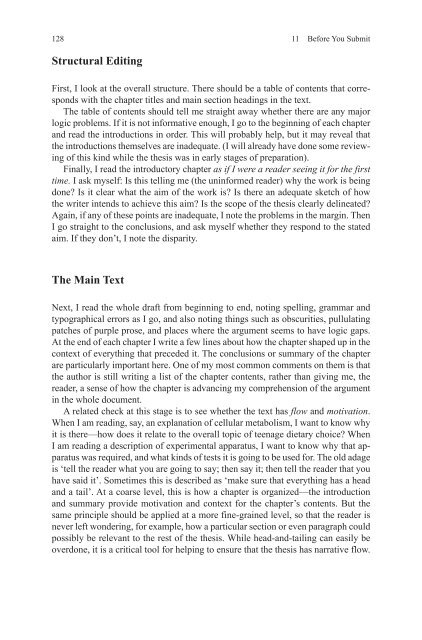How-to-Write-a-Better-Thesis
Create successful ePaper yourself
Turn your PDF publications into a flip-book with our unique Google optimized e-Paper software.
128 11 Before You Submit<br />
Structural Editing<br />
First, I look at the overall structure. There should be a table of contents that corresponds<br />
with the chapter titles and main section headings in the text.<br />
The table of contents should tell me straight away whether there are any major<br />
logic problems. If it is not informative enough, I go <strong>to</strong> the beginning of each chapter<br />
and read the introductions in order. This will probably help, but it may reveal that<br />
the introductions themselves are inadequate. (I will already have done some reviewing<br />
of this kind while the thesis was in early stages of preparation).<br />
Finally, I read the introduc<strong>to</strong>ry chapter as if I were a reader seeing it for the first<br />
time. I ask myself: Is this telling me (the uninformed reader) why the work is being<br />
done? Is it clear what the aim of the work is? Is there an adequate sketch of how<br />
the writer intends <strong>to</strong> achieve this aim? Is the scope of the thesis clearly delineated?<br />
Again, if any of these points are inadequate, I note the problems in the margin. Then<br />
I go straight <strong>to</strong> the conclusions, and ask myself whether they respond <strong>to</strong> the stated<br />
aim. If they don’t, I note the disparity.<br />
The Main Text<br />
Next, I read the whole draft from beginning <strong>to</strong> end, noting spelling, grammar and<br />
typographical errors as I go, and also noting things such as obscurities, pullulating<br />
patches of purple prose, and places where the argument seems <strong>to</strong> have logic gaps.<br />
At the end of each chapter I write a few lines about how the chapter shaped up in the<br />
context of everything that preceded it. The conclusions or summary of the chapter<br />
are particularly important here. One of my most common comments on them is that<br />
the author is still writing a list of the chapter contents, rather than giving me, the<br />
reader, a sense of how the chapter is advancing my comprehension of the argument<br />
in the whole document.<br />
A related check at this stage is <strong>to</strong> see whether the text has flow and motivation.<br />
When I am reading, say, an explanation of cellular metabolism, I want <strong>to</strong> know why<br />
it is there—how does it relate <strong>to</strong> the overall <strong>to</strong>pic of teenage dietary choice? When<br />
I am reading a description of experimental apparatus, I want <strong>to</strong> know why that apparatus<br />
was required, and what kinds of tests it is going <strong>to</strong> be used for. The old adage<br />
is ‘tell the reader what you are going <strong>to</strong> say; then say it; then tell the reader that you<br />
have said it’. Sometimes this is described as ‘make sure that everything has a head<br />
and a tail’. At a coarse level, this is how a chapter is organized—the introduction<br />
and summary provide motivation and context for the chapter’s contents. But the<br />
same principle should be applied at a more fine-grained level, so that the reader is<br />
never left wondering, for example, how a particular section or even paragraph could<br />
possibly be relevant <strong>to</strong> the rest of the thesis. While head-and-tailing can easily be<br />
overdone, it is a critical <strong>to</strong>ol for helping <strong>to</strong> ensure that the thesis has narrative flow.














![[Lonely Planet] Sri Lanka](https://img.yumpu.com/59845622/1/169x260/lonely-planet-sri-lanka.jpg?quality=85)


